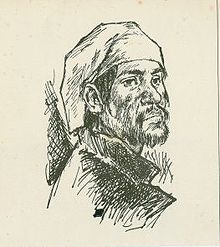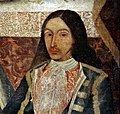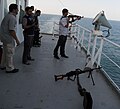Introduction
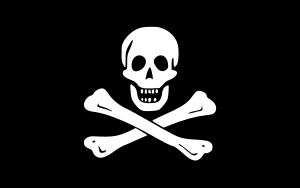
Piracy is an act of robbery or criminal violence by ship or boat-borne attackers upon another ship or a coastal area, typically with the goal of stealing cargo and other valuable goods. Those who conduct acts of piracy are called pirates, and vessels used for piracy are called pirate ships. The earliest documented instances of piracy were in the 14th century BC, when the Sea Peoples, a group of ocean raiders, attacked the ships of the Aegean and Mediterranean civilisations. Narrow channels which funnel shipping into predictable routes have long created opportunities for piracy, as well as for privateering and commerce raiding.
Historic examples of such areas include the waters of Gibraltar, the Strait of Malacca, Madagascar, the Gulf of Aden, and the English Channel, whose geographic structures facilitated pirate attacks. The term piracy generally refers to maritime piracy, although the term has been generalized to refer to acts committed on land, in the air, on computer networks, and (in science fiction) outer space. Piracy usually excludes crimes committed by the perpetrator on their own vessel (e.g. theft), as well as privateering, which implies authorization by a state government.
Piracy or pirating is the name of a specific crime under customary international law and also the name of a number of crimes under the municipal law of a number of states. In the 21st century, seaborne piracy against transport vessels remains a significant issue, with estimated worldwide losses of US$25 billion in 2023, increased from US$16 billion in 2004. (Full article...)
Selected biography -
D. Miguel Enríquez (c. 1674–1743), was a privateer from San Juan, Puerto Rico, Spain, who operated during the early 18th century. A mulato born out of wedlock, Enríquez was a shoemaker by occupation. After working for the governor as a salesman he was recruited to defend Puerto Rico, then a part of the Spanish Empire, and commanded a small fleet that intercepted foreign merchant ships and other vessels dedicated to contraband. These outlaws were thriving in the waters of the Caribbean Sea and the Atlantic Ocean, notably in the areas surrounding Saint Thomas, Curaçao and Jamaica. Operating during the height of the Golden Age of Piracy, his fleet was also credited with controlling the proliferation of buccaneers in the region. However, he was considered a pirate himself by the enemies of Spain, since it was common practice of the government to ignore when foreign ships were attacked. After some time operating independently, Enríquez received a letter of marque and reprisal from the Spanish Crown, this was a special permit granting him the privileges of a privateer. Corsairs from Puerto Rico were often called guardacostas, or "coast guards". They operated in the same fashion as any other pirate, the only difference was that they did it in the name of Spain, protecting imperial trade restrictions. Employing a systematic approach, Enríquez was able to become the most successful and influential Puerto Rican of his time. However, despite this, he was never able to gain the acceptance of the higher social classes, something that he strived to earn throughout his life.
During his years as a privateer, Enríquez established close links with the Spanish Monarchy. His ships were also responsible for the distribution of urgent messages that arrived at San Juan or La Aguada to the rest of the Spanish viceroyalties. When there was a shortage of royal vessels, Enríquez's fleet was responsible for transporting items on behalf of Spain without charge. His fleet also provided transportation for the authorities that arrived at Puerto Rico en route to other locations and for missionaries. Throughout the War of the Spanish Succession, Enríquez's ships were responsible for guarding the Antilles from British and Dutch incursions. Among the places where he established connections was the adjacent island of St. Thomas. Enríquez also dealt directly with the governor of Curaçao. At a time when letters of marque were being regularly issued in neighboring islands his actions converted San Juan into one of the most important ports in the Caribbean. Between 1702 and 1713 Enríquez owned a fleet of more than thirty vessels, losing at least a dozen and capturing more than twenty others. By the time that his career was over, he had reportedly commanded a fleet of over 300 privateer ships, of which approximately 150 were lost, employing close to 1,500 sailors. (Full article...)Selected article -

Regarded as the last successful pirate of the Caribbean during the 19th century's suppression era, the life of Roberto Cofresí has been romanticized in his native Puerto Rico and neighboring nations. Already possessing a reputation as hard to capture in life, the freebooter became a symbol for an archipelago immersed in the political unrest caused by its status as a colony within the struggling Spanish Empire. Under these circumstances, Cofresí was soon characterized as a benign and generous thief. In a similar trend, he was also associated with the Puerto Rican independence movement of the era. During the late 19th and early 20th century, the abundant oral tradition led to a subgenre of folk hero literature which depicted Cofresí as a benevolent force and contradicted the other pirate-related works of the time, including the well known Treasure Island and Peter Pan. A century later, this contrast became the subject of sociological study. Research to uncover the historical figure behind these myths has also been published by authors linked to the Puerto Rican Genealogical Society, which creates a parallel to this narrative.
While in prison, Cofresí claimed to possess at least 4,000 pieces of eight still accessible after the authorities confiscated his ship, mentioning them in an unsuccessful attempt to bribe an officer in exchange for his freedom. This made him one of the few pirates that are implied to have kept a hidden cache, a rare occurrence despite its prominence in popular culture due to their tendency to divide and misspend the earnings, and fueled legends of buried treasures waiting to be found. All sort of objects serve as the subjects of these tales, from magic guitars made of solid gold to chests that are bound to chains that emerge from the sea. This tendency had extended to Hispaniola by the end of the 19th century, with a novel claiming that the island served as the locale of such treasures. During the 20th century, the destination marketing organizations in the region took notice of them and began exploiting the association of certain places and the pirate to attract tourism. Raising his profile during this time period also led to several non-profit homages. Cofresí has since served as the namesake of several sport teams and events, vehicles, companies, alcoholic brands and hotels. Figures such as Alejandro Tapia y Rivera, Luis Lloréns Torres, Rafael Hernández Marín and Juan Emilio Viguié worked to adapt the legends to other mediums, including plays, popular music and films. Cofresí is also the only pirate of the pre-flight era to have a copycat crime in his stead recorded during the 20th century. This happened when his name was employed as an alias during the first act of sky piracy involving an American airline. (Full article...)Did you know?
- ... that since 1904 the Gasparilla Pirate Festival in Tampa, Florida, has featured a pirate-themed parade?
- ... that Saudi Arabian broadcaster beoutQ pirated and resold beIN Sports programmes during the Qatar diplomatic crisis?
- ... that HMS Redpole, one of the aptly-named coffin brigs, sank in an action with a pirate vessel in August 1828?
- ... that indigenous Australian artist Daniel Boyd has depicted colonial figures including Captain James Cook and Governor Arthur Phillip as pirates?
- ... that the developers of Hotline Miami 2: Wrong Number suggested that Australian customers pirate their game?
- ... that in the Golden Age of Piracy, the word "pirate" was often spelled "pyrate" or "pyrat"?
- ... that there is only one account of walking the plank?
- ... that in 2011, pirates were reported as raiding along the Danube River in the center of Europe?
Selected quotations
| “ | Now for our affair's are on the razor's edge, men of Ionia, wither we are to be free or slaves ... so if you will bear hardships now, you will suffer temporarily but be able to overcome your enemies | ” |
| — Dionysius the Phocaean | ||
General images
Selected Jolly Roger

Subcategories
Topics
WikiProjects
Related portals
Things you can do
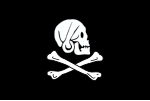
Contribute
- Work on piracy and pirate articles and help improve them to featured articles.
Expand
Join
WikiProject Piracy Requests
- eliminate red links from List of pirates
- expand Timeline of piracy, specifically to fill in vast gap between the 1890s to 2000s
- revise Bartholomew Roberts
- help with Requested articles and Expand articles
- help with Portal:Piracy
- Create Modern Piracy
Associated Wikimedia
The following Wikimedia Foundation sister projects provide more on this subject:
-
Commons
Free media repository -
Wikibooks
Free textbooks and manuals -
Wikidata
Free knowledge base -
Wikinews
Free-content news -
Wikiquote
Collection of quotations -
Wikisource
Free-content library -
Wikiversity
Free learning tools -
Wiktionary
Dictionary and thesaurus
